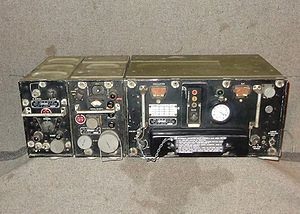Wireless Set No. 29
| Wireless Set No. 29 | |
|---|---|
 | |
| Production history | |
| Introduced | 1945 |
The remarkable thing about the 29 set, and a criteria that must have driven its developers nuts, was that it not only had to do everything a 19 set did (or better) including frequency range, operating on RT and CW and having an A set, B set and intercom, but it also had to fit into the exact same space and mount every component…from the aerial bases, to the control units to the set itself…in existing 19 set holes. It was even compatible to existing 19 set installations in armoured vehicles and trucks; you could replace the 19 set with a 29, and still use all the existing cables, connectors, control units and aerials from the 19 set as-is. The 29 set did, however, have its own unique aerials, control units, headsets and accessories. Again similar to the 19 set, the 29 ran on either a 12 or 24 volt DC supply manually set by an internal switch.
The set itself was configured a little differently however. Unlike the 19 set that had the power supply unit on the left and the sender/receiver (made up of the A set, B set and Intercom portions) on the right, the 29 set had the A sender/receiver on the right, the power supply in the centre and the B and intercom combined in one unit on the left. This last unit could be used as a stand-alone set if required.
The A set operated between 2and 8 M Hz just as the 19 set did, but had a somewhat complicated method of setting the frequency. The operator had to first set the RF dial to one of 12 fixed positions spaced 500 kHz apart (2.0, 2.5, 3,0, 3,5 MHz etc.) just below the desired frequency, then complete the kHz adjustment with the oscillator dial using either a black or red scale depending on whether he was above or below the half MHz RF setting. It did, however, enable crystal accuracy eliminating the need for netting calls and the use of a crystal calibrator to establish a desired frequency. A key lock-protected high power setting increased the range from 8 to 10 miles on low power, to 20 to 25 miles on high, a feature which made it equivalent to the much larger Canadian Amplified and British High Power 19 sets. Another handy feature was the ability to preset three channels, red white and blue. Not only was this an improvement over the two 19 set ‘flick position’ pre-sets, the 29 set's selections were motor driven instead of mechanical so the tuner, oscillator and aerial tuning unit (variometer) would all move by themselves to the correct position with the push of a button on the face of the set. The B set had only two pre-set channels: 235 MHz and 245 MHz with a range of 1000 yards. The 29 A, B/IC and Supply Units are held on to the set carrier by studs and quick release levers which, if you’ve ever had to remove a 19 set from its carrier, you’d have to agree is a big improvement.
While not waterproof, the 29 set was splash and dust proof and solidly built. The cable connections were all secured with threaded screw-on rings at the connector’s ends and the control units are cast instead of spot welded stampings as 19 set ones were. When not in use, the set’s cable connectors were protected by screw on covers (see photo 1). Other simple improvements were incorporated to aid the operator such as colour coding the fuses to make their replacement easy and error free, and a meter that didn’t require the operator to know numerical values; if the needle was in the ‘red zone’, the reading was acceptable.
Related Pages
- No related pages at this time
Related Items
References
- ↑ Information from Bruce Parker


